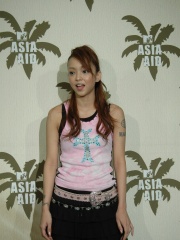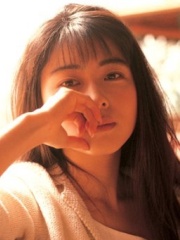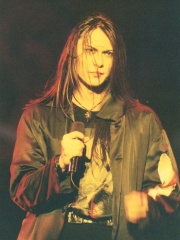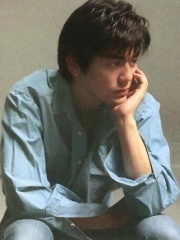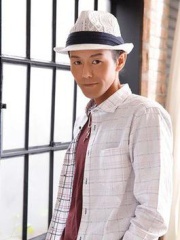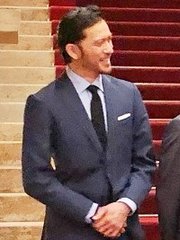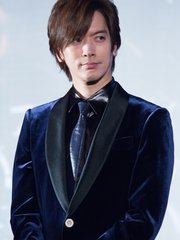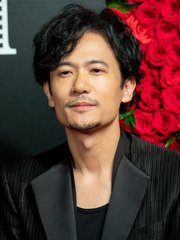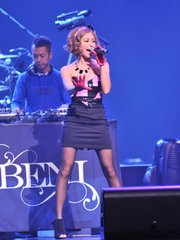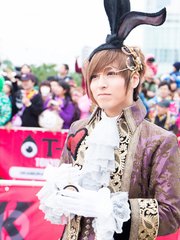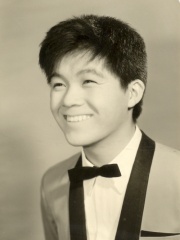



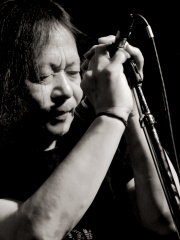
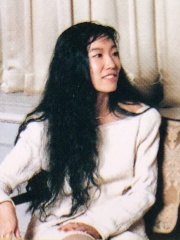

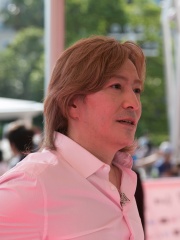
The Most Famous
SINGERS from Japan
Top 10
The following people are considered by Pantheon to be the top 10 most legendary Japanese Singers of all time. This list of famous Japanese Singers is sorted by HPI (Historical Popularity Index), a metric that aggregates information on a biography's online popularity. Visit the rankings page to view the entire list of Japanese Singers.

1. Kyu Sakamoto (1941 - 1985)
With an HPI of 64.51, Kyu Sakamoto is the most famous Japanese Singer. His biography has been translated into 33 different languages on wikipedia.
Hisashi "Kyu" Sakamoto (Japanese: 坂本 九, Hepburn: Sakamoto Hisashi or Sakamoto Kyū; 10 December 1941 – 12 August 1985), legally registered as Hisashi Ōshima (大島 九, Ōshima Hisashi) since 1956, was a Japanese singer and actor. He was best known outside Japan for his international hit song "Ue o Muite Arukō" (known as "Sukiyaki" in English-speaking markets), which was sung in Japanese and sold over 13 million copies. It reached number one in the United States Billboard Hot 100 in June 1963, making Sakamoto the first Asian recording artist to have a number one song on the chart. He was also the first Japanese artist to have a number one single on the Australian singles chart. Sakamoto died on 12 August 1985 in the crash of Japan Air Lines Flight 123.

2. Mariya Takeuchi (b. 1955)
With an HPI of 61.21, Mariya Takeuchi is the 2nd most famous Japanese Singer. Her biography has been translated into 32 different languages.
Mariya Takeuchi (竹内 まりや, Takeuchi Mariya; born 20 March 1955) is a Japanese singer-songwriter and record producer. Regarded as the "Queen of City Pop", Takeuchi is one of the best-selling music artists in Japan with over 16 million records sold. Internationally, her 1985 song "Plastic Love" became a sleeper hit and the catalyst of the 21st century revival of city pop. Takeuchi was born in Taisha, Hikawa district, now the city of Izumo, Shimane, and attended Keio University. She signed with RCA in 1978, releasing five albums under the label which appeared on the Oricon Charts, including her chart-topping third effort Love Songs (1980). She terminated her contract with RCA in 1981 and announced a temporary hiatus. In 1982, she married singer and songwriter Tatsuro Yamashita. She signed with Moon Records in 1984, and internationally released her sixth studio album Variety that same year to commercial success. She has since released seven more studio albums and one live album. All of her works have continued to appear on the Oricon Charts, and since 2001, each one of her albums have topped it. Takeuchi has stayed with the Moon record label, working with the different branches since signing in 1984; since 1998, she has also been signed with Warner Music Japan. Her single "Inochi no Uta" (いのちの歌; Song of Life), when re-recorded in 2020, made her the oldest Japanese singer to have a single top the Oricon Charts.

3. Miyuki Nakajima (b. 1952)
With an HPI of 58.39, Miyuki Nakajima is the 3rd most famous Japanese Singer. Her biography has been translated into 18 different languages.
Miyuki Nakajima (中島 みゆき, Nakajima Miyuki) (born February 23, 1952, Sapporo, Hokkaidō, Japan) is a Japanese singer-songwriter and radio personality. She has released 44 studio albums, 48 singles, 6 live albums and multiple compilations as of January 2020. Her sales have been estimated at more than 21 million copies. In the mid-1970s, Nakajima signed to Canyon Records and launched her recording career with her debut single, "Azami Jō no Lullaby" (アザミ嬢のララバイ). Rising to fame with the hit "The Parting Song (Wakareuta)", released in 1977, she has since had a successful career as a singer-songwriter, primarily in the early 1980s. Four of her singles have sold more than one million copies in the last two decades, including "Earthly Stars (Unsung Heroes)", a theme song for the Japanese television documentary series Project X. Nakajima performed in experimental theater ("Yakai") every year-end from 1989 through 1998. The idiosyncratic acts featured scripts and songs she wrote, and have continued irregularly in recent years. In addition to her work as a solo artist, Nakajima has written over 90 compositions for numerous other singers and has produced several chart-toppers. Many cover versions of her songs have been performed by Asian (particularly Taiwan and Hong Kong) singers. She is the only musician to have participated in the National Language Council of Japan.

4. Ayumi Hamasaki (b. 1978)
With an HPI of 58.07, Ayumi Hamasaki is the 4th most famous Japanese Singer. Her biography has been translated into 54 different languages.
Ayumi Hamasaki (浜崎あゆみ, Hamasaki Ayumi; born October 2, 1978) is a Japanese singer-songwriter and producer. Nicknamed the "Empress of Pop" on account of her influence throughout Asia, she is widely recognized for her versatile music production, songwriting, and live performances. Hamasaki is the best-selling solo artist in Japan, and a cultural icon of the Heisei era. Born and raised in Fukuoka, Hamasaki moved to Tokyo in 1993 to pursue a career in modeling and acting. In 1998, Hamasaki released her debut single "Poker Face" and debut major-label album A Song for ××. The album debuted at the top of the Oricon charts and remained there for five weeks, selling over a million copies. This rapid rise to fame was attributed to her lyrics, listeners praising her insight and relatability. Her next ten albums shipped over a million copies in Japan, with her third, Duty, selling nearly three million. A Best, her first compilation album, further established her position as a crowning artist with more than four million copies sold in Japan. It was at this time that she represented more than 40% of her record label's income. After A Best, Hamasaki went on to experiment with her music style and lyricism, incorporating English into her work from Rainbow onwards. Later albums would range from electronic dream-pop to rock genres, the singer commenting that she focuses on what she wants to create "whether it is trendy or not". Hamasaki currently holds the record for the most albums to place in the top ten by a female artist in Japan. Hamasaki has sold over fifty million units in Japan, and has several domestic record achievements for her singles: the most number-one hits by a female artist (38); the most consecutive number-one hits by a solo artist (25), and the most million-sellers. From 1999 to 2010, Hamasaki had at least two singles each year topping the charts. Hamasaki is also the first female recording artist to have ten studio albums since her debut to top the Oricon, and the first artist to have a number one album for thirteen consecutive years since debut. Hamasaki's remix albums Super Eurobeat Presents Ayu-ro Mix and Ayu-mi-x II Version Non-Stop Mega Mix, are also recognized as two of the best selling remix albums of all time worldwide.

5. Seiko Matsuda (b. 1962)
With an HPI of 57.37, Seiko Matsuda is the 5th most famous Japanese Singer. Her biography has been translated into 26 different languages.
Noriko Kamachi (蒲池 法子, Kamachi Noriko; born 10 March 1962), known professionally as Seiko Matsuda (松田 聖子, Matsuda Seiko), is a Japanese singer-songwriter, known for being one of the most popular Japanese idols of the 1980s. Since then, she has continued to release new singles and albums, put on annual summer concert tours, and perform at winter dinner shows. She makes frequent appearances in high-profile TV commercials and movies, and on radio. Her alma mater is Chuo University. Due to her popularity in the 1980s and her long career, she has been dubbed the "Eternal Idol" by the Japanese media. In January 2011, the Japanese music television program Music Station listed her as the 2nd best-selling idol of all time in Japan, with 29,510,000 records sold. She placed right behind pop group SMAP and ahead of Akina Nakamori, her biggest rival of the 1980s, who was listed in third place. In 2016, however, Ian Martin of The Japan Times compared her output unfavorably with that of Hikaru Utada, describing Matsuda as "first and foremost an idol rather than an artist. Her legacy is best expressed in singles rather than albums." Matsuda once held the record of 25 number-one hits for musicians from 1983 to 2000 (broken by B'z) and for female solo artists (broken by Ayumi Hamasaki in 2010). Matsuda was a performer on the finale of Kouhaku (Red White Music Battle) in 2014 and 2015, the prestigious NHK New Year's Eve Music show on which she has performed 24 times (as of 2020).

6. Damo Suzuki (1950 - 2024)
With an HPI of 56.92, Damo Suzuki is the 6th most famous Japanese Singer. His biography has been translated into 20 different languages.
Kenji Suzuki (鈴木健次, Suzuki Kenji; 16 January 1950 – 9 February 2024), known as Damo Suzuki (ダモ鈴木), was a Japanese musician best known as the vocalist for the German Krautrock group Can between 1970 and 1973. Born in 1950 in Kobe, Japan, he moved to Europe in 1967 where he was spotted busking in Munich, West Germany, by Can bassist Holger Czukay and drummer Jaki Liebezeit. Can had just split with their vocalist Malcolm Mooney, and asked Suzuki to sing over tracks from their 1970 compilation album Soundtracks. Afterwards, he became their full time singer, appearing on the three influential albums Tago Mago (1971), Ege Bamyası (1972) and Future Days (1973). After leaving Can in 1973, he abandoned music and became a Jehovah's Witness. Having left that organisation, he returned to music in the mid-1980s and began to tour widely. Over the following decades, Suzuki recorded a large number of albums under different aliases, which he later grouped as "Damo Suzuki's Network".

7. Yumi Matsutoya (b. 1954)
With an HPI of 56.80, Yumi Matsutoya is the 7th most famous Japanese Singer. Her biography has been translated into 18 different languages.
Yumi Matsutoya (松任谷 由実, Matsutōya Yumi; born January 19, 1954), nicknamed Yuming (ユーミン, Yūmin), is a Japanese singer, composer, lyricist and pianist. Generally the writer of both the lyrics and the music in her songs, she is renowned for her idiosyncratic voice and live performances, and is one of the most prominent figures in the history of Japanese popular music. Her recording career has been commercially successful with more than 42 million records sold. In 1990, her album The Gates of Heaven became the first album to be certified "2x million" by the RIAJ, and she has had twenty-one No. 1 albums listed on the Oricon charts. She is the only artist to have at least one number-one album every year on the Oricon charts for 18 consecutive years. After gaining several years of experience as a session musician, she debuted as a singer-songwriter in 1972. During her early career, she worked under her maiden name Yumi Arai (荒井 由実, Arai Yumi). In 1975, Arai became known as a composer for "Ichigo Hakusho wo Mou Ichido", a commercially successful song recorded by the folk duo BanBan. She also gained popularity as a vocalist in the same year through the success of "Ano Hi ni Kaeritai", which became her first number-one hit on Japan's Oricon Charts. "Haru-yo, Koi" is another of her famous songs. She also uses the name Kureda Karuho (呉田軽穂), which is derived from the Swedish film star Greta Garbo, when offering her work to other musicians. In The Encyclopedia of Contemporary Japanese Culture, it is written that "Yuming incorporated influences from progressive rock and European pop to produce a sophisticated, upper-middle-class female Japanese voice and sound in a contemporary musical and journalistic world dominated by discussions of folk music and social critique. This musical idiom is generally thought to have been first realised on [...] Cobalt Hour". The album The 14th Moon and the three albums that ranked in the top 10 of the Japanese charts in 1976 (Cobalt Hour, Yuming Brand, and Hikōki-gumo) "contained several songs which are considered to be early classics of the J-pop genre." After marrying her musical collaborator Masataka Matsutoya in 1976, Arai began recording under her married name and has continued to do so. Throughout the 1980s, Matsutoya's music was prominently featured in advertisements for Mitsubishi Motors in her native Japan and her image was used to promote their vehicles. In addition to multiple hit singles, she has obtained enormous commercial success on the Japanese Albums Chart, particularly during the late 1980s and the first half of the 1990s. The magazine Shūkan Gendai ranked Matsutoya third (behind only Miyuki Nakajima and Masayoshi Son) in a list of the smartest Japanese figures that was determined based on the criteria of "intelligence, determination, sensibility and capability".

8. Akina Nakamori (b. 1965)
With an HPI of 55.96, Akina Nakamori is the 8th most famous Japanese Singer. Her biography has been translated into 19 different languages.
Akina Nakamori (中森 明菜, Nakamori Akina; born 13 July 1965) is a Japanese singer, songwriter, record producer and actress. She is one of the most popular and best-selling music artists in Japan. Akina achieved national recognition after winning the 1981 season of the talent show Star Tanjō!. Her debut single "Slow Motion" was released to moderate success, peaking at number thirty on the Oricon Weekly Singles Chart. Nakamori's popularity increased with the release of her follow-up single, "Shōjo A", which peaked at number five on the Oricon charts and sold over 390,000 copies. Her second album Variation became her first number-one on the Oricon Weekly Albums Chart, staying in that position for three weeks. She made her acting debut in 1985 with an appearance in the Japanese romance movie Ai, Tabidachi . After an extended hiatus from 2010 to 2014, Akina released two compilation albums, All Time Best: Original and All Time Best: Utahime Cover, both of which were commercially successful.

9. Tetsuya Komuro (b. 1958)
With an HPI of 55.94, Tetsuya Komuro is the 9th most famous Japanese Singer. His biography has been translated into 21 different languages.
Tetsuya Komuro (小室 哲哉, Komuro Tetsuya; born November 27, 1958) is a Japanese musician, songwriter and record producer. He is recognized as the most successful producer in Japanese music history and has introduced contemporary electronic dance music to the Japanese mainstream. He was also a former owner of the disco Velfarre located in Roppongi, Tokyo. In the Oricon singles chart of April 1996, he monopolized all the top 5 positions as the songwriter and producer, a world record. In 1995, he monopolized all top 3 positions of the copyright distribution rankings for the JASRAC Award, a record in Japan's music history. At his peak as a record producer the artists he predominantly produced for came to be known as TK Family and at one time included Namie Amuro, hitomi, TRF, Tomomi Kahara and Ami Suzuki amongst others. As of 2008, records produced by him had sold more than 170 million copies, primarily in Japan. Total sales of the singles he has written exceed 42 million copies, making him the fourth best-selling lyricist in Japan.
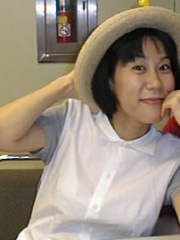
10. Yoko Kanno (b. 1963)
With an HPI of 55.76, Yoko Kanno is the 10th most famous Japanese Singer. Her biography has been translated into 31 different languages.
Yoko Kanno (菅野 よう子, Kanno Yōko; born 18 March 1963) is a Japanese composer, arranger and music producer of soundtracks for anime series, video games, television dramas and movies. She has written scores for Cowboy Bebop, Terror in Resonance, Ghost in the Shell: Stand Alone Complex, Wolf's Rain, Turn A Gundam and Darker than Black. Kanno is a keyboardist and the frontwoman for Seatbelts, who perform many of her compositions.
People
Pantheon has 150 people classified as Japanese singers born between 1941 and 2002. Of these 150, 143 (95.33%) of them are still alive today. The most famous living Japanese singers include Mariya Takeuchi, Miyuki Nakajima, and Ayumi Hamasaki. The most famous deceased Japanese singers include Kyu Sakamoto, Damo Suzuki, and Izumi Sakai. As of April 2024, 27 new Japanese singers have been added to Pantheon including Shizuka Kudo, Yoko Takahashi, and Ado.
Living Japanese Singers
Go to all RankingsMariya Takeuchi
1955 - Present
HPI: 61.21
Miyuki Nakajima
1952 - Present
HPI: 58.39
Ayumi Hamasaki
1978 - Present
HPI: 58.07
Seiko Matsuda
1962 - Present
HPI: 57.37
Yumi Matsutoya
1954 - Present
HPI: 56.80
Akina Nakamori
1965 - Present
HPI: 55.96
Tetsuya Komuro
1958 - Present
HPI: 55.94
Yoko Kanno
1963 - Present
HPI: 55.76
Namie Amuro
1977 - Present
HPI: 55.69
Joji
1992 - Present
HPI: 55.00
Hironobu Kageyama
1961 - Present
HPI: 54.62
Masashi Tashiro
1956 - Present
HPI: 54.55
Deceased Japanese Singers
Go to all RankingsKyu Sakamoto
1941 - 1985
HPI: 64.51
Damo Suzuki
1950 - 2024
HPI: 56.92
Izumi Sakai
1967 - 2007
HPI: 55.19
Atsushi Sakurai
1966 - 2023
HPI: 55.09
Yutaka Ozaki
1965 - 1992
HPI: 52.94
Kōji Wada
1974 - 2016
HPI: 50.92
Kwon Ri-se
1991 - 2014
HPI: 42.91
Newly Added Japanese Singers (2025)
Go to all RankingsShizuka Kudo
1970 - Present
HPI: 51.26
Yoko Takahashi
1966 - Present
HPI: 50.96
Ado
2002 - Present
HPI: 47.58
Tomoya Nagase
1978 - Present
HPI: 46.64
Daigo
1978 - Present
HPI: 46.37
Aiko
1975 - Present
HPI: 45.52
Goro Inagaki
1973 - Present
HPI: 45.34
Shoko Aida
1970 - Present
HPI: 45.20
Beni
1986 - Present
HPI: 44.61
Yui Mizuno
1999 - Present
HPI: 43.47
Moa Kikuchi
1999 - Present
HPI: 42.90
Shouta Aoi
1987 - Present
HPI: 42.60
Overlapping Lives
Which Singers were alive at the same time? This visualization shows the lifespans of the 6 most globally memorable Singers since 1700.

